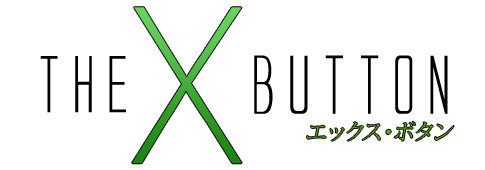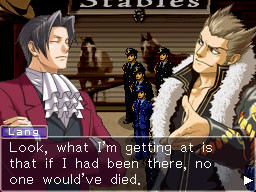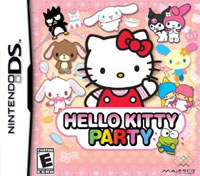- remind me tomorrow
- remind me next week
- never remind me
The X Button
Theme Music
by Todd Ciolek,

Well, it's time for another X Button. So what's in the news? Oh yeah, Square Enix deciding to bring Final Fantasy XIII to North America on March 9, apparently for the Xbox 360 as well as the PlayStation 3. That may be overshadowed by the simultaneous decision to replace the game's Japanese theme song, Sayuri Sugawara's “Kimi ga Iru Kara” with the new Leona Lewis single, “My Hands.”
Some fans raged about Square Enix sullying their precious Final Fantasy with such crass Western pop music, but many didn't seem to mind. Perhaps that's because theme songs are the most disposable part of any modern Final Fantasy game. Square Enix has trotted out famous-in-Japan singers for Final Fantasy ending themes ever since Faye Wong belted out awkward English phrases for Final Fantasy VIII's “Eyes on Me," but most are forgettable. The only one I can recall is Final Fantasy X's “Suteki Da Ne.”

Some may point out that Leona Lewis' piano-backed trinket wasn't written explicitly for Square Enix's creation, but let's be honest: past Final Fantasy songs don't connect with their games too closely. So perhaps we shouldn't judge this new theme song until we've seen it connected to crystals and futuristic cities and doomed romance and Oerba Yun Fang (above). Then we can hate it.
NEWS
ENDLESS FRONTIER EXCEED ADDS MORE OLD CHARACTERS
 You know, I think I'll shorten up the title to Super Robot Wars OG Saga Endless Frontier from now on. Sure, it's a spin-off of Super Robot Wars and its Original Generation sub-series, but Endless Frontier has arguably taken on a life of its own. It has many of the same royalty-free robots that made Super Robot Wars interesting beyond anime all-stars, but the game's an RPG full of combo-heavy battles and jiggling princesses, catgirls, mermaids, fox-spirits, and combat androids. It's also getting a sequel in the form of Endless Frontier Exceed.
You know, I think I'll shorten up the title to Super Robot Wars OG Saga Endless Frontier from now on. Sure, it's a spin-off of Super Robot Wars and its Original Generation sub-series, but Endless Frontier has arguably taken on a life of its own. It has many of the same royalty-free robots that made Super Robot Wars interesting beyond anime all-stars, but the game's an RPG full of combo-heavy battles and jiggling princesses, catgirls, mermaids, fox-spirits, and combat androids. It's also getting a sequel in the form of Endless Frontier Exceed.
While Exceed's headliners are tribal warrior Aledei and busty elf-maid grenadier Neige (right), it's also throwing in the principal cast of the original game: bounty hunter Haken Browning, split-personality fembot Aschen, underdressed princess Kaguya, robot-puppeteer princess Sakuya, Namco X Capcom stars Reiji and Xiaomu, and Xenosaga icon KOS-MOS. While they look much as they did in the first game, they'll have some new attacks here and there. It's all on shameless display at the game's rocking-out website.
AGAREST AIN'T A PLAYSTATION 3 EXCLUSIVE NO MORE
Remember how Record of Agarest War was among the PlayStation 3 exclusives covered here last week? A few days after that, Aksys Games announced that it's coming out next year as a retail title for the Xbox 360 as well, so boy, I look dumb. But it's good news for Xbox 360 owners, who'll get to fight strategy-RPG battles and sire future generations of heroes by marrying various RPG-heroine stereotypes.
ACE ATTORNEY INVESTIGATIONS DEMO OPEN TO ALL
 Miles Edgeworth: Ace Attorney Investigations may not be the biggest game of 2010, but there are many out there who are looking forward to nothing more than this, the first Phoenix Wright title to officially star rival prosecutor Miles Edgeworth. Considering that the game isn't out until February, Capcom's promoting it early with a special flash demo hosted at several different sites. The faux DS brings up the first case, re-introducing Edgeworth, his cravat, and his police sidekick Dick Gumshoe. Those used to the Phoenix Wright games will note the new emphasis on investigations and the new graphics engine, though Edgeworth's logical deductions follow routes similar to Phoenix's courtroom work. Those used to the Phoenix Wright games will also giggle frequently over the dialogue here.
Miles Edgeworth: Ace Attorney Investigations may not be the biggest game of 2010, but there are many out there who are looking forward to nothing more than this, the first Phoenix Wright title to officially star rival prosecutor Miles Edgeworth. Considering that the game isn't out until February, Capcom's promoting it early with a special flash demo hosted at several different sites. The faux DS brings up the first case, re-introducing Edgeworth, his cravat, and his police sidekick Dick Gumshoe. Those used to the Phoenix Wright games will note the new emphasis on investigations and the new graphics engine, though Edgeworth's logical deductions follow routes similar to Phoenix's courtroom work. Those used to the Phoenix Wright games will also giggle frequently over the dialogue here.
THE XBOX 360 IN 2010
This column's preview of 2010's games continues with the Xbox 360, which really isn't getting that many exclusives likely to interest the anime crowd. Not to say that there aren't a number of generally promising games ahead, so let's play fast and loose with just what our readership is interested in playing.
ALAN WAKE
Developer: Remedy Entertainment
American Publisher: Microsoft
Coming: May 2010
Alan Wake doesn't directly imitate Silent Hill, but it pulls from many of the same sources: David Lynch movies, Jacob's Ladder, Stephen King's better fiction, and so on. The last of these is particularly important, as Alan Wake stars an author apparently stuck in one of his own horror novels, one he didn't actually write yet. Plagued by writer's block, the titular Alan wanders a deceptively quiet little town and encounters his own creations as well as unspeakable horrors. You know how it is.

Eschewing the limited exploration of a Resident Evil or Silent Hill, Alan Wake allows players to roam the town freely, albeit with specific points driving the plot forward. Like any survival-horror lead, Alan arms himself with everyday implements of destruction, though he'll also use light itself to drive back enemies. The town has a nicely realistic look, and Microsoft's clearly seen enough potential in Alan Wake to hold back the PC version until the 360 one is on the market.
ESPGALUDA II BLACK LABEL
Developer: Remedy Entertainment
Japanese Publisher: Cave
Coming: Second Quarter 2010
Cave is one of many Japanese developers comfortable with being crammed into a niche. That's because Cave makes mostly shooters, with the occasional genre-breaker like last year's Princess Debut. Those shooters are dominated by screen-filling flurries of bullets, unique play mechanics, and, all too often, cutesy anime-girl characters. Amid Cave titles full of gothic-lolita witches and bug-riding schoolgirl princesses, the ESP series is relatively reserved and cleverly designed. It'd be an excellent signature series for Cave, but the developer seldom promotes it. The original game, ESP Ra.De, never came to a home system, and ESPgaluda didn't make many waves when it went from the arcade to the PlayStation 2. But now ESPgaluda II is coming to the Xbox 360, and I'm delusionally certain that this, this will be Cave's standout hit.

ESPgaluda offers the same storms of enemy fire that Cave uses in just about all of its games, but with one twist: by using a special energy meter, players can slow down oncoming bullets, weaving in and out of massive clouds of pastel-colored death. ESPgaluda II complicates just about everything its predecessor explored, making it so that destroyed enemies fire even more last-ditch bullets, which are defused by taking out other enemies. It's a lengthy chain of play mechanics that forces one to balance point-scoring opportunities with pure survival. Black Label, the Xbox 360 port of ESPgaluda II, will look nicer and sport several yet-to-be-announced features in comparison to its arcade counterpart. The important thing is that it will likely be region-free like Cave's other Xbox 360 port, Mushihime-sama Futari. This means that anyone should be able to play it on any Xbox 360, and that I'm fully justified in mentioning it here.
NIER GESTALT
Developer: Cavia
Publisher: Square Enix
Coming: Second Quarter 2010
As half of Square Enix and Cavia's bizarre dual-game experiment, Nier Gestalt remains exclusive to the Xbox 360, while the PlayStation 3 gets Nier Replicant. Gestalt is perhaps the grittier of the two games and, dare we suggest, the one aimed at Americans. Nier, who's a Final Fantasy-lookin' hero out to save his sister in Replicant, is a grizzled old grouch in Gestalt, and he's trying to rescue his daughter with the help of a hermaphrodite (officially confirmed, yes) sidekick.

A Nier Gestalt demo at the Tokyo Game Show showed off a graphically impressive and slightly more subdued take on Devil May Cry hacking and slashing, with Nier carving his way through monstrous foes and hurling magical attacks when his huge sword wasn't elaborate enough. It offered some interesting sights and some particularly huge enemies, though some were quick to point out how it lagged behind the upcoming Bayonetta in terms of overkill. This seems to be Cavia's lot. I'm sure some of you remember when their Bullet Witch went up against Devil May Cry 4.
PROJECT NATAL
Developer: Microsoft
Japanese Publisher: Microsoft
Coming: November 2010
Much of Project Natal is still uncertain, including the most important part: the games that will use Microsoft's response to the Wii. As a sensor that attaches to the Xbox 360, Natal tracks the player's movements without the apparent need for a remote sensor to be waved around. It's a controller-free Wii mixed with Sony's Eye Toy, and it's supposedly sensitive enough to find its way around furniture.

As for the games, Microsoft's shown mostly simple demos, including a Breakout clone and a painting program. Katamari Damacy and Space Invaders titles also appeared, though Lionhead Studios' kid-raising Milo and Kate seems to be the most prominent game made for the system. Of course, that's because most Natal developers haven't yet announced their lineups. The possibilities are indeed broad, though the mind reels at what Natal might do for otaku-oriented singing-dancing games like Idolm@ster and Dream Club C.
AND…UH…
OK, so the Xbox 360 exclusives for 2010 don't really skew toward the Naruto and Final Fantasy kids. But there's still plenty to like. Mass Effect 2, for example, is BioWare's impressive follow-up to one of the best space-opera RPGs since...well, Anachronox. Yeah, it's been that long. But faint praise shouldn't deter anyone from Mass Effect 2's polishing of the original game. And the story seems like a Seven Samurai spin on sci-fi conventions, with the first game's Commander Shephard recruiting interplanetary rogues to take on a mysterious new threat. That's sort of the plot to Roger Corman's Battle Beyond the Stars, but it's been a while since that movie, too.
RELEASES FOR THE WEEK OF 11-22
HELLO KITTY PARTY Developer: Sanrio?
Developer: Sanrio?Publisher: Majesco Platform: DS Players: 1-2 MSRP: $29.99 Next week's only new Japan-made title is a Hello Kitty mini-game collection, and I blame Modern Warfare 2 for that. Of course, the current generation of early grade-school girls into Hello Kitty will enjoy this, at least, since it spans just about every genre they might like. There's a dancing game, a bunch of Mario Party competitions, and a substitute for Cooking Mama. The sewing mini-game is of particular academic interest, since I don't think I've ever heard of a DS game venturing into that field. Of course, Hello Kitty Party's diversions also feature every major adorable little Sanrio corporate product, from Keroppi to the vile, soulless penguin abomination known as Badtz-Maru.
|
Also Shipping: The PSP version of Tekken 6.
EXTRA LIVES: ANIME COVERED UP
There's something strangely amusing about the way Japanese games were censored just when they dominated the industry. From the start of the NES era to the mid-1990s, North American companies imported Japan-made games while simultaneous stripping any anime artwork from their covers. We previously explored how seldom manga-style art reached American game boxes, and now it's time for a look at just how companies over here replaced anime artwork.
Perhaps there's no better example than Sega's Phantasy Star II. A sci-fi RPG cherished by many, it's shot through with all sorts of anime influences. Here's a scene of the two main characters, Nei and Rolf.

And here's the Japanese cover, showing Rolf much as he appears in the game.

And here's what Rolf and Nei looked like on the American cover.

Sega's trend of replacing Phantasy Star art continued through Phantasy Star IV, which brought in Boris Vallejo himself to turn this…

…into this…

In some ways, the Phantasy Star series was lucky to be overhauled by professional artists. I'm sure everyone knows what happened to the original Mega Man. Sadly, this was not an isolated incident for Capcom, a company that employed some of the most talented artists in the Japanese game industry. Even when Capcom games were weak, the illustrations were impressive, and that was the case with the first two Breath of Fire RPGs.

In Japan, anyway. Everyone else saw this on the box...

This trend of overhauling RPG artwork perhaps peaked with Konami's American release of the original Suikoden. Here's its Japanese cover, featuring art by character designer Junko Kawano.

And here's the American equivalent.

Yet one of the finest examples of unrelated cover art arose this decade, when budget-title publisher XS Games bought the rights to two shooters: Gunbird for the PlayStation and Shikigami no Shiro for the PlayStation 2.


Together, these two completely unrelated games became Mobile Light Force.

The same cover was used for the PlayStation and PlayStation 2 titles, despite the fact that the Charlie's Angels trio appears in neither. Yet you will find one of Gunbird's robot characters renamed the MILF 2000.
All of this barely scratches the surface. There's much more to the world of terrible, needlessly altered game covers, including the tale of Jaleco and an otherwise forgettable brawler called Rival Turf!

But that's a story for another day.
discuss this in the forum (27 posts) |
this article has been modified since it was originally posted; see change history